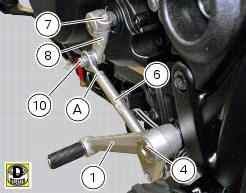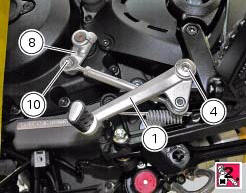
Ducati Diavel Service Manual: Refitting the gearchange mechanism
Make sure that the gearchange linkage assembly (6) is installed with the ball joint with a left-hand thread (a) facing the lever (8).
Apply the recommended grease to the non-threaded surface of the pin (4).
Fit the first o-ring (5) in the pin (4).
Start the pin (4) in the gearchange lever (1). Smear recommended grease on the second o-ring (5). Insert the second o Ring (5) and the washer (9).
Apply the recommended threadlocker to the threaded side of the pin (4). Fit the gearchange lever (1) on the footrest bracket and tighten the pin (4) to a torque of 23 nm +/- 10% (sect. 3 - 3, Frame torque settings).
Fit the lever (8) on the gearchange control assembly, and start the screw (10).
Tighten the screw (10) to the torque of 10 nm +/- 10% (sect. 3 - 3, Frame torque settings).
Fit the gear control unit inserting the lever (8) on the gear control pin, apply threadlocker on the screw (7) and insert it on the lever (8).
Tighten the screw (7) to a torque of 10 nm +/- 10% (sect. 3 - 3, Frame torque settings).


 Disassembly of the gearchange mechanism
Disassembly of the gearchange mechanism
Refer to the exploded view at the beginning of this section for indications
on disassembly and renewal of gearchange
components.
If the bushing (2) inside the pedal (1) needs replacing, grease t ...
 Fork
Fork
...
Other materials:
Refitting the number plate holder
Place the number plate light (5), as indicated, on the number plate holder
plate (8) and tighten the screws (7) to a torque
of 2 nm +/- 10% (sect. 3 - 3, Frame torque settings).
Thread the number plate light wiring (c) into the opening in the number plate
holder plate as shown.
Fit ...
Steering lock on indication
This function informs that the steering lock was turned on.
The steering lock can be turned on during the first 60
seconds after turning off the vehicle by pressing down on the
"run" button.
If the steering lock was enabled correctly, the instrument
panel will show the indication ...
Hydraulic clutch control
Special screw
Sealing washer
Clutch master cylinder
Clutch hydraulic pipe (metal braid)
Screw
Spare stand
Washer
Microswitch
Pin
Bleed valve
Screw
Roller
O-ring
Clutch control rod
Clutch lever
Dust cap
Bleed valve
Special screw
Sealing washer
Boot
Plug
...